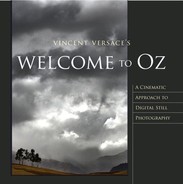Creating Stardust
When most people think of movie-star images from the 1930s and ’40s, George Hurrell’s classic photographs come to mind. With his iconic portraits of Greta Garbo, Jean Harlow, and Gary Cooper, Hurrell invented the Hollywood glamour photograph, and his dramatic use of light was second to none.
Hurrell most often used two focusable light sources, which he diffused and placed above and on either side of his subject. This type of lighting became known as “butterfly lighting” because of the hallmark shadow it produced under the subject’s nose.
He lit his famous subjects with movie or hot lights, not strobes, and photographed them with an 8 3 10 view camera, not an SLR. He didn’t have the luxury of roll film or CompactFlash cards. He would engage his actor subjects in dialogue, and from time to time he’d click the shutter. The images he captured were the result of those experiences.
Note
An early version of this chapter appeared in The PhotoshopWorld Dream Team Book, Vol. 1 (New Riders/Peachpit Press, 2005).
In Stardust, the model on the bearskin was lit naturally with reflected sunlight. This takes advantage of the unique characteristic of sunlight to be both directional and ambient at the same time. The technique selected to light the base capture image is called “board-to-board reflecting.” It’s used to get light from someplace other than a point light source (in this case the sun), or to make the light source appear to be farther from the subject than it actually is. (See sidebar.) Here, that technique was the best way to evenly light the subject with the best type of light—reflected sunlight.
Note
The reason I prefer to use reflected natural light is that it has a glowing quality that I have not seen in any other type of light. Also, when doing environmental portraiture, this approach gives me light that is simultaneously directional and ambient: directional because the reflector provides a point light source; ambient because the light is naturally present. This allows the subject more freedom of movement, which typically produces a more spontaneous photograph. I have found that the poses people naturally assume are often far more interesting than those I suggest.
I chose this lighting technique, not only for aesthetic reasons, but to save time and money. All I needed were two light stands with light disk holders, and two reflectors. Setup and breakdown times were insignificant, and the reflected sunlight was a bonus; again, the more you know about the middle, the more informed your choices can be at the beginning (Figure 4.3).
Figure 4.3. The lighting setup for the Stardust image: Two reflectors direct sunlight onto the subject.

